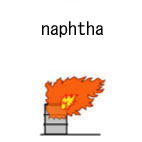| Case Name |
Leakage and fire of naphtha and hydrogen caused due to a tightening problem of a flange at a naphtha catalytic reforming unit |
| Pictograph |

|
| Date |
August 17, 1990 |
| Place |
Arita, Wakayama, Japan |
| Location |
Refinery |
| Overview |
During usual operation, gas leaked from the reactor's inlet flange at a naphtha catalytic reforming unit. It seemed that insufficient tightening was the cause. A check for loose flange nuts and bolts was done every six months, but this was insufficient. Enforcement of management is good after an accident, but it is strongly required to study the reason why the previous management system failed. |
| Incident |
At a naphtha catalytic reforming unit of a refinery, hydrogen and naphtha at a high temperature leaked and ignited at the top flange of a reactor due to insufficient tightening torque between a bolt and a nut. The operating condition of the reactor was 3.2 MPaG, and about 490 °C. |
| Processing |
Manufacture |
| Individual Process |
Reaction |
| Chemical Reaction |
Other (catalytic reforming) |
| Substance |
Hydrogen, Fig2 |
| Naphtha |
| Type of Accident |
Leakage, fire |
| Sequence |
At 06:37 on August 17th, 1990; a operator in charge found a fire at the inlet flange at the top of the reactor at a naphtha catalytic reforming unit, and carried out an emergency shutdown at once. Following the shutdown, the pressure in the reactor lowered and the fire gradually died down.
07:01; the fire was extinguished. |
| Cause |
There was uneven tightening torque at about five of twenty bolts at the inlet flange of the reactor, stress concentrated, there was a creep phenomenon, and they became loose. As a result, a gap was formed at the flange. A high-temperature mixture of hydrogen and naphtha leaked from the gap, and ignited. |
| Response |
When the plant was shut down, the fire died down, and it was extinguished with a mobile steam fire extinguisher. |
| Countermeasures |
Reinforcement of tightening management of flange nuts and bolts, enforcement of checks on tightening torque of nuts and bolts, enforcement of re-tightening, execution of a leak test near the plant where the accident occurred once a month, and enforcement of checks at similar plants. |
| Knowledge Comment |
If a check does not provide useful results, it is meaningless. |
| Background |
There was a periodic inspection every six month for loose nuts and bolts, but it seemed that this check was not done properly. It was assumed that the inspection was inadequate and it brought about an imbalance of tightening torque. |
| Reason for Adding to DB |
Example of fire caused due to a meaningless inspection |
| Scenario |
| Primary Scenario
|
Poor Value Perception, Poor Safety Awareness, Inadequate Risk Recognition, Organizational Problems, Poor Management, Poor Operation Management, Usage, Maintenance/Repair, Insufficient Inspection, Bad Event, Mechanical Event, Looseness of Bolt, Failure, Deformation, Creep, Secondary Damage, External Damage, Leakage/Fire
|
|
| Sources |
Fire and Disaster Management Agency, Fire at inlet flange of second cat-reforming unit, Accident cases of dangerous materials. 1990, pp.112-113
High Pressure Gas Safety Inst. of Japan. Catalytic reforming unit. Fire caused by flange leakage in reactor inlet piping. Accident examples of Petroleum refinery and Petrochemical units. pp.65-66 (1995)
|
| Number of Deaths |
0 |
| Number of Injuries |
0 |
| Financial Cost |
Approximately ¥ 1,000,000 (High Pressure Gas safety Inst. of Japan) |
| Multimedia Files |
Fig2.Chemical formula
|
| Field |
Chemicals and Plants
|
| Author |
WADA, Yuji (National Institute of Advanced Industrial Science and Technology)
TAMURA, Masamitsu (Center for Risk Management and Safety Sciences, Yokohama National University)
|
|